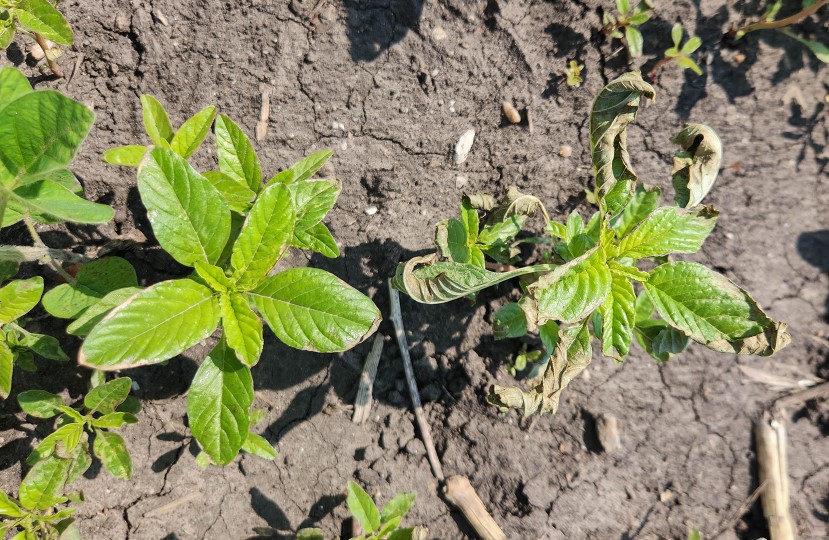
Side-by-side waterhemp plants show varied herbicide response—one damaged but regrowing, the other unaffected. This field will require a follow up herbicide application. (Photo: ISA/Alex Schaffer)
Waterhemp escape highlights herbicide resistance challenges
June 12, 2025 | Kriss Nelson
Iowa Soybean Association’s (ISA) research agronomists have been carefully surveying farmers' fields, noting early weed challenges.
According to Alex Schaffer, ISA's senior research agronomist, a glufosinate herbicide application several days earlier in one field failed to completely control weeds.
"While walking an on-farm trial last week, I found two waterhemp plants growing side by side. One plant clearly showed the effects of the herbicide application, while the other did not. The damaged plant had produced new growth indicating it will survive the herbicide application,” Schaffer says. “That soybean field will need a reapplication of post herbicide as soon as possible to keep waterhemp under control.”
“Effective waterhemp management requires a proactive, integrated approach. This field example highlights how even a minor lapse in timing, coverage or weather conditions can open the door to herbicide resistance and reduced control,” says Schaffer.
Five key takeaways for managing herbicide-resistant weeds
1. Use multiple sites of action
In Enlist soybean systems, tank mixing 2,4-D choline with glufosinate can significantly improve weed control. Including a Group 15 residual herbicide in the post-emergence application helps prevent additional flushes of waterhemp, which can emerge throughout the growing season, typically from May through August in Iowa.
2. Monitor weather conditions
Herbicides targeting actively growing plants are most effective under warm, sunny conditions. Cool, wet or cloudy weather slows plant metabolism, making it harder for herbicides to be absorbed and translocated. Spraying during periods of low growth can lead to reduced efficacy.
3. Follow adjuvant recommendations
Many herbicide labels include adjuvant guidelines for improved performance. These may include ammonium sulfate (AMS) to condition hard water and non-ionic surfactants or crop oil concentrates to aid herbicide penetration through the plant cuticle. This is important to make sure the herbicide makes it to its site of action.
4. Optimize coverage
Because glufosinate is a contact herbicide, thorough coverage is critical. Proper nozzle selection and an adequate gallons-per-acre (GPA) rate are essential to ensure the product uniformly coats the plant. Insufficient coverage leads to incomplete control.
5. Target small weeds
Weed size at application is a major factor in herbicide success. Fast-growing weeds like waterhemp can quickly outpace the effective window for control, especially if weather delays treatment. Early applications, combined with a residual herbicide, provide the best chance to limit escapes and reduce future pressure.
Written by Kriss Nelson.
Back